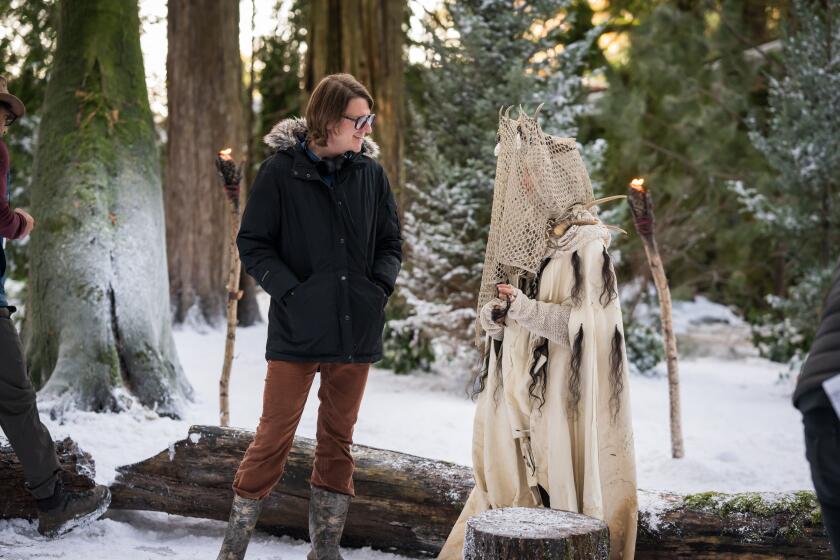The Lucas Museum of Narrative Art is a bad idea. Here’s why
- Share via
The ginned-up contest between Los Angeles and San Francisco to lure filmmaker George Lucas and his long-aborning Lucas Museum of Narrative Art is done. Los Angeles lost by winning.
The announcement came this month that the museum would indeed be coming here, one day to fill a couple of parking lots in Exposition Park. That’s a loss because the museum is a terrible idea.
A billion dollars is about to be wasted on a project whose dubious artistic mission could have been turned into something useful — and even profound. Instead, an ugly stepsister’s foot is being jammed into a fragile glass slipper.
Here is the sound of the breaking glass: Jobs! Tourism! Tax revenue!
Money drove the vanity museum’s civic sales pitches. Between the household-name franchises for the blockbuster movies “Star Wars” and “Indiana Jones,” there’s hardly a bigger, richer celebrity catch than Lucas.
Mayor Eric Garcetti issued a gung-ho advocacy statement for the project in June, saying, “Tens of millions of people visit our city every year — and L.A. has unquestioned stature as a world arts capital.” Supervisor Mark Ridley-Thomas touted more numbers, adding that the museum would bring 1,500 construction jobs and another 350 permanent jobs to L.A.
Garcetti then upped that ante on announcement day, saying that the 275,000-square-foot building will lead to tens of thousands of jobs in construction and more than a thousand permanent jobs — “and that’s a lowball estimate.”
For the sake of argument, let’s grant city hall their numbers. The calculations beg the most important question: Here in our “world arts capital,” how would a Lucas Museum of Narrative Art finally measure up? What is terrific about it as an art museum?
Not much, I daresay. And that’s not because the bulk of the Lucas collection is pop culture material, as I’ll explain momentarily.
It’s because the plan instead ignores a powerful art museum infrastructure already existing in L.A., one that desperately needs what Lucas could bring to the table. In return, those important museums could actually achieve his fondest dream, which is serious cultural credibility for the art he champions.
That won’t happen with his vanity museum. Major opportunities are being missed.
Little of the Lucas collection has been publicly shown. According to reports, most of it tracks aspects of the birth and gestation of modern mass-media imagery, starting 150 years before the epochal recent revolution of digital culture, as well as a few artists’ responses to it.
Victorian and early 20th century illustrations for magazines, posters and children’s books, especially British and American, are reportedly a major holding. Artists include Maxfield Parrish, Arthur Rackham, Beatrix Potter, Frank Adams and — of course — Norman Rockwell. (His calendar art and magazine cover designs number more than 140.) Many names overshadowed and even forgotten — Paul Stahr, Jessie Willcox Smith — are also represented.
There are lots of movie set designs, costumes and storyboards made for fantasies like “The Wizard of Oz” and the “Star Wars” saga; Winnie the Pooh books; Max Fleischer drawings of Betty Boop; Garry Trudeau’s “Doonesbury” comic strips; and many of R. Crumb’s Zap Comix, plus his magnificently strange illustrations to the Book of Genesis, drawn in 2009.
There’s a small group of paintings by Edgar Degas, Winslow Homer, Pierre-Auguste Renoir and Everett Shinn. A few works by notable contemporary artists — Kara Walker, Rirkrit Tiravanija — have been added more recently, and more are promised.
The reason this sprawl doesn’t make for a coherent museum is right there staring us in the face — not “lost” like that pesky Ark of the Covenant that set Indiana Jones on his outlandish quest. It’s hiding in plain sight in the Lucas Museum of Narrative Art’s very name.
Simply: “Narrative art” is a made-up category. The fiction is as fantastical as the Cloud City run by Han Solo’s scoundrel friend, Lando Calrissian, whose mining colony extracts valuable Tibanna gas from the depths of the giant planet Bespin.
But I digress. As I was saying, narrative art is a made-up category. Every time I ask artists what they think of a Museum of Narrative Art, the reply is some variation of “What’s that?” If artists don’t know, the museum’s artistic mission is screwy.
The Lucas Museum website has a section called “What is narrative art?” But it’s no help.
“Narrative art is visual art that tells a story,” it explains, merely repeating the same concept twice with different phrasing. A perfect tautology — that’s nothing to build an art museum around.
They’re not talking here about Michelangelo’s 16th century story of the Creation, which unfolds on the ceiling of the Sistine Chapel. Or about Dong Qichang’s thrilling journeys across 17th century Chinese landscape scrolls into deep cultural and natural history. Or an Edo ikegobo, the cylindrical “altar to the hand” that tells a sculptural story of an 18th century person’s achievements in what is now Nigeria.
If they were, a fledgling museum of narrative art would be desperate to acquire Orazio Gentileschi’s breathtaking 1621-23 painting “Danaë,” a sensational nude wrapped inside the cautionary story of a fateful pagan rape. The greatest storytelling Baroque masterpiece to come to market in half a century sold last year at auction for a hefty $30.5 million, but Lucas — a billionaire five times over — didn’t buy it.
The Getty did. That’s because the Getty is a museum dedicated to art — specifically art made in Europe before the modern era, plus photographs. It knows what it’s about. What it’s not about is art hemmed in by hollow adjectives, like so-called “narrative” art.
That’s as silly as, say, a Museum of Colorless Art would be. A Diane Arbus black-and-white photograph of a young boy grasping a toy hand-grenade in sunny Central Park would make little sense hanging next to a voluptuous Aubrey Beardsley ink drawing of writhing Salome. Both speak of diabolical beauty made without a lick of color, but “colorless art” is just not a thing.
Neither is narrative art. Here it’s just a puffed-up euphemism for illustration. That’s a perfectly legitimate form of mass art, which is the actual category that seems to describe most of Lucas’ diverse collection. For whatever reason, though, he seems determined to pretend it’s not.
A Lucas Museum might be wildly entertaining — a requirement of any major mass art, such as “American Graffiti.” That extraordinary Lucas movie effectively trembles on the brink of the national nervous breakdown that engulfed us in the traumatic year of 1963. But given the muddled mission, don’t expect the museum to be nearly as culturally incisive.
Normally, without first-hand exposure to the art that will make up its permanent collection, I wouldn’t weigh in on Lucas’ proposed museum. Around 700 objects will kick it off, but I haven’t seen them, though I was invited to have a look at a small sample. If the mission is nonsensical, as this specious notion of a discrete storytelling art surely is, what’s the point?
Besides, it was pretty obvious that I was being enticed to get into a hometown bidding war against critic Charles Desmarais, my counterpart at the San Francisco Chronicle, who was also invited. The contest was cranked up again in October, this time in architectural terms, with the simultaneous unveiling of two sleek building concepts by architect Ma Yansong, one for San Francisco’s Treasure Island and another for L.A.
Framing the museum plan as a civic contest was politically savvy. Since 2013, Lucas had failed twice in singular attempts to bring his museum idea first to San Francisco’s Presidio and then Chicago. Nearly 73, he doesn’t have last-chance time to spare. Cranking up a contest shifted discussion away from “Should there be a narrative art museum?” to “Where should the museum be?”
Lucas has been vocal in his enthusiasm for the history of mass art forms and his dismay at what he sees as snobbish establishment disdain for them. Maybe he missed great shows like the huge, definitive “Masters of American Comics” held jointly at the UCLA Hammer Museum and Museum of Contemporary Art in 2005, a marvelous, in-depth presentation of work by 15 artists from the past century.
That art museum effort is a template for what Lucas ought to do now, if he really wants to be taken seriously. Virtually everything reported to be in his collection would fit easily within existing L.A. art museums.
Illustration in the UCLA Grunwald Center for the Graphic Arts. American and European paintings at LACMA. Movie material at the new Academy Museum. Photographs at the Getty. Contemporary art at MOCA and the Hammer. British books and illustration at the Huntington Library. Etc.
Mass art has indeed been ghettoized, as Lucas suggests, but the solution to that tough problem is not to drop the fanciest-shmanciest ghetto project the world has ever seen into Expo Park — a gated community for which everyone gets the entry code. The solution is to push existing art museums to integrate mass art into their larger art programs.
Lucas, perhaps alone among mass art enthusiasts, has both the collection and the financial clout to do it. Smart philanthropy would tie them together: Target art gifts and hundreds of millions of dollars in endowment funds for acquisitions, shows, scholarship and publishing, matched with general operating funds that would allow those educational enterprises to thrive without today’s crushing commercial pressures. Museum doors would be thrown wide open.
The most disheartening aspect of the current proposal, aside from its wastefulness, is the claim made on the museum’s website that divisions between high art and popular art are artificial and need to be eradicated. That’s just wrong.
The differences are real — as real as the differences between a decorated glass decanter and an oil painting, both of which get housed together in art museums. Most obvious: Effective mass culture requires mass popularity, while successful art culture doesn’t.
Both are stronger for the dissimilarity. Homogenizing critical differences between them merely accelerates cultural entropy, turning everything into uniform gray sludge. That makes the planned museum pernicious.
Forty-four years ago, the late critic Roger Ebert rightly described “American Graffiti” as “a brilliant work of historical fiction.” Storytelling art. Lucas is often very good at it.
But not this time. On social media I dubbed it the Treacle Museum — a sentimental vanity gallery pumped up on soppy emotional steroids. Artistically, the proposed art museum has all the makings of a billion-dollar flop.
The Lucas Museum of Narrative Art has it inside-out. It’s really just the Narrative Museum of Lucas Art. The garbled story it tells is about one wildly successful mass-culture filmmaker whose deep desire is to be publicly recognized as an artist.
Ironically, by not bringing mass art into the larger story that art museums already tell, he’s about to throw away an unrivaled opportunity for exactly that.
More to Read
The biggest entertainment stories
Get our big stories about Hollywood, film, television, music, arts, culture and more right in your inbox as soon as they publish.
You may occasionally receive promotional content from the Los Angeles Times.











